TL;DR:
- Mental health disorders affect one in eight people globally, with limited access to treatment due to various barriers.
- Automated mental health tools like chatbots and sentiment analysis are emerging but lack depth in assisting professional psychotherapy.
- Researchers from Carnegie Mellon University and UC Santa Barbara propose “Diagnosis of Thought” (DoT) prompting, an innovative AI approach for cognitive distortion detection.
- DoT comprises three steps: subjective evaluation, contrastive reasoning, and schema analysis, offering a comprehensive assessment of a patient’s speech.
- Large Language Models (LLMs), like ChatGPT and GPT-4, show remarkable potential in enhancing psychotherapy with over 10% relative gains in distortion evaluation and 15% in classification.
- The collaboration between AI and psychotherapy communities aims to provide secure, AI-driven support to revolutionize mental health services.
Main AI News:
In today’s world, approximately one in eight individuals grapple with mental health issues. Despite the prevalence of these challenges, mental health disorders remain significantly underserved, plagued by issues such as a shortage of mental health professionals, suboptimal treatment options, exorbitant costs, and societal taboos. Astonishingly, treatment coverage for mental health services stands at a mere 33% in high-income regions, dwindling to a paltry 8% in low- and lower-middle-income areas. Recent findings from the American Psychological Association (APA) reveal that six out of ten psychologists are no longer accepting new patients, exacerbating the crisis. In response to these pressing concerns, tireless efforts have been channeled into developing automated tools that provide mental health support, including compassionate chatbots and sentiment analysis, aiming to mitigate the impact of this global predicament.
Nonetheless, existing initiatives often fall short, offering superficial heuristic solutions like emotion analysis and comforting responses. There remains much ground to cover in terms of integrating such technologies effectively into professional psychotherapy. This necessitates a deeper exploration of patients’ cognitive processes, the development of cognitive models, and the refinement of techniques for reconstructing these intricate cognitive frameworks. Traditional therapeutic approaches, such as cognitive-behavior therapy (CBT) and acceptance and commitment therapy (ACT), hinge on these principles. Yet, their implementation in professional psychotherapy faces considerable hurdles, mainly due to the confidential nature of the data documenting interactions between patients and licensed practitioners.
In light of recent strides in Large Language Model (LLM) development, it is increasingly evident that these models possess exceptional prowess in addressing a variety of text-based reasoning challenges, even in a zero-shot environment. Innovations like ChatGPT and GPT-4 have demonstrated significant promise in the classic Sally-Anne exam, which tests the fundamental theory of the mind’s ability to attribute mental states, such as beliefs and emotions. Beyond this, harnessing their capabilities for intricate cognitive analysis and reasoning holds immense potential. The time is ripe to embark on the journey of constructing expert, well-organized AI support tailored for psychotherapy. The first stride in this direction involves a crucial facet of cognitive behavior therapy (CBT) – the identification of cognitive distortions.
Enter the researchers from Carnegie Mellon University and the University of California, Santa Barbara, who propose the groundbreaking “Diagnosis of Thought” (DoT) prompting method, inspired by the nuanced diagnostic techniques employed by psychotherapy experts during patient interactions. DoT unfolds in three distinct stages to assess a patient’s speech: subjective evaluation, contrastive reasoning, and schema analysis. In the subjective evaluation phase, they meticulously distinguish the patient’s subjective notions from objective facts. Contrastive reasoning then comes into play, extracting the rationales both for and against the patient’s ideas. Finally, in the schema analysis phase, the researchers summarize the underlying cognitive schema, linking it to various forms of cognitive distortions.
With the latest state-of-the-art Large Language Models (LLMs) at their disposal, extensive trials were conducted. The results are remarkable, with DoT achieving relative gains exceeding 10% for distortion evaluation and a staggering 15% for classification when applied to ChatGPT in zero-shot settings. Crucially, the diagnostic process remains transparent, thanks to the generated justifications throughout the three-step procedure, further corroborated by human specialists for quality assurance. This research underscores the immense potential of LLMs in elevating the standards of professional psychotherapy. It serves as a stepping stone for a more ambitious collaborative endeavor, inviting both the AI and psychotherapy communities to unite in a joint venture. The ultimate objective? To deliver expert, secure, AI-driven assistance that can revolutionize and enhance mental health support systems.
Conclusion:
The development of the “Diagnosis of Thought” (DoT) prompting method, powered by Large Language Models, signifies a transformative leap in the field of psychotherapy. It offers the promise of more accurate and accessible mental health support, addressing the pressing needs of the one-in-eight individuals worldwide who grapple with mental health disorders. This innovative approach is poised to reshape the market by bridging the gap between technology and professional psychotherapy, ushering in a new era of improved mental health care.

